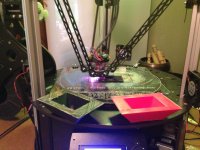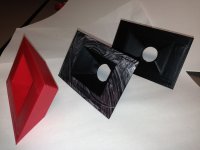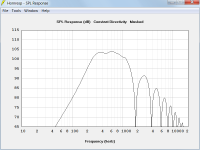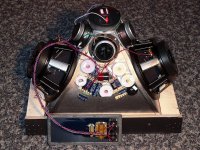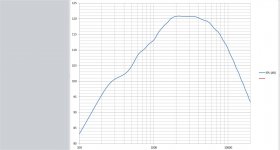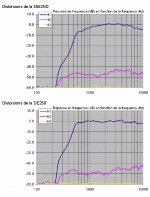hulkss, how hard do you think it would be to integrate a pair of 10 or 12' woofers into the design? Would it mess up the midrange too badly?
You would just need to extend the horn further to make it big enough. The midrange will be essentially unaffected.
You would be adding two octaves from 300 to 150 Hz and 150 to 75 Hz. Subwoofers can pick-up from there on down.
Many people use a separate mid bass enclosure. A simple sealed enclosure with a 15" driver would do fine under the synergy horn.
Keep in mind what makes this easy for me: digital crossover networks with Audoilense or Acourate
Thinking of mount in a corner so the walls form a natural extension of the horn.
I have a folded bass horn in each front corner. The synergy horn will go on top.
I agree that metalic cone drivers (The Aurasound diaphragm is titanium) can sound harsh due to break-up modes in the diaphragm. That is why I am using a high frequency 1" compression driver with a polyimide cone (B&C DE 250).
In the case of this midrange application, the driver is covering only two octaves: 300 to 600 Hz and 600 to 1200 Hz. With that in mind, I selected a small but powerful driver with the the purpose of operating it in the range of true piston motion.
A key feature of the AuraSound driver is the perimeter voice coil, the same as a compression driver. This drives the cone only from the outer edge to minimize bending forces in the cone:


Keep in mind this driver it tiny. The cone is the same size as the B&C compression driver diaphragm. Any cone break-up is well above the range I am using it in. In addition the band-pass nature of the midrange port further reduces any unwanted high frequency output.
Even though this driver is tiny, four of them will still easily reach 120 dB output in the horn. This is limited by port air velocity at 300 Hz, not the driver (ports are 3/4" diameter).
If you are concerned about the perceived sound quality of the AuraSound 2" driver look here: Pluto Loudspeaker
I see your point... May be I'm wrong. Anywhere, this is very interesting project.
That little Aurasound driver does sound pretty nice. Its sensitivity is dreadfully low, though, so.. active crossovers recommended.
Bill, my simulations in Hornresp and Akabak show 100 dB per watt (2.83 volts) for the midrange horn 4 driver system. Not at all what I would call dreadfully low sensitivity.
This post by Bill got me started on the Synergy adventure: DIY Synergy/Unity spreadsheet
Last edited:
Horn Throat Adapter Test Parts
A friend of mine built a rapid prototyping machine: Rostock MAX
It pumps hot molten ABS plastic out of a tiny nozzle to make parts. His test parts are looking good. You can see the interior of the throat adapter is honeycomb in the machine photo.


Next I'll get some of that material I'm planning to use to reduce horn mouth diffraction. I need to determine if I can fit it to the horn OK and check the actual dimensions.
A friend of mine built a rapid prototyping machine: Rostock MAX
It pumps hot molten ABS plastic out of a tiny nozzle to make parts. His test parts are looking good. You can see the interior of the throat adapter is honeycomb in the machine photo.
Next I'll get some of that material I'm planning to use to reduce horn mouth diffraction. I need to determine if I can fit it to the horn OK and check the actual dimensions.
Attachments
Hi Hulk:
re' low sensitivity - well 84 db for a single driver is low. but 4 of them plus horn gain adds up to enough.
Before I go, let me compliment on your work. Its impressive. I'm envious of the design tools you have access to and respect the amount of work you've done with them. What follows isn't an indirect criticism. I really would like to know.
Could you walk me through your thinking on why you went through what seems to be a great deal of trouble to extend the mid range response to 2 Khz when you crossover way down at 1200 Hz? Would that discontinuity at 2Khz be there if you hadn't put that peak on top of the reflection null? I recall Tom Danley himself recommending placing the reflection null right at crossover or vice versa to get the most acoustic filtering. You aren't doing that and I'd like to understand why. My guess would be that you feel that using DSP for crossover and equalization gives you the freedom not to.
Thanks,
Jack
re' low sensitivity - well 84 db for a single driver is low. but 4 of them plus horn gain adds up to enough.
Before I go, let me compliment on your work. Its impressive. I'm envious of the design tools you have access to and respect the amount of work you've done with them. What follows isn't an indirect criticism. I really would like to know.
Could you walk me through your thinking on why you went through what seems to be a great deal of trouble to extend the mid range response to 2 Khz when you crossover way down at 1200 Hz? Would that discontinuity at 2Khz be there if you hadn't put that peak on top of the reflection null? I recall Tom Danley himself recommending placing the reflection null right at crossover or vice versa to get the most acoustic filtering. You aren't doing that and I'd like to understand why. My guess would be that you feel that using DSP for crossover and equalization gives you the freedom not to.
Thanks,
Jack
Could you walk me through your thinking on why you went through what seems to be a great deal of trouble to extend the mid range response to 2 Khz when you crossover way down at 1200 Hz?
I noticed in many web postings of Synergy horns, the difficulty of getting decent midrange bandwidth. As I posted earlier, I now have an actual measurement of the ported midrange speaker:
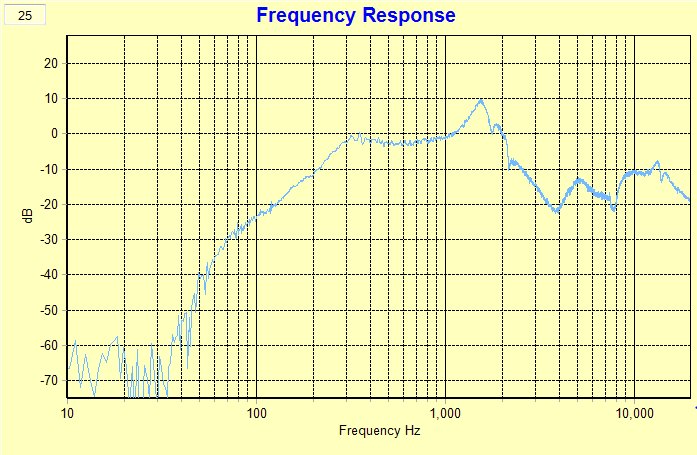
The response of the horn when excited directly by an offset driver (no front chamber or port to form a 4th order bandpass enclosure) looks like this:
Now if you add these two responses together, you get those plots showing extended midrange bandwidth. In reality it is a combination of two bad responses: one with a big resonant peak and the other with massively bad comb filtering.
I'm hoping the midrange sounds good up to my goal of 1200 Hz. Any more will be a bonus.
Here's a speaker I bought from Sound Physics Labs when Tom Danley worked there. I disconnected the crossover and tri-amped them with digital XO. The midranges just made it to a crossover point of 900 Hz.
Attachments
Last edited:
Sorry for the very nube question but how do you determine port size for these mids while not adding port noise?
I am sure it is easy but I wanted to know where you start at figuring this out. I was looking at just getting some mids that have been mentioned on here before and building a simple mockup like the 2" mid picture and going from there. I need to learn HornResp but also learn better with just building. So I will start simming but all this talk has me wanting to build something. Just wish I didnt have a bunch of large PHL mids. Wish they were smaller mids to play with but its a start to learn
I am sure it is easy but I wanted to know where you start at figuring this out. I was looking at just getting some mids that have been mentioned on here before and building a simple mockup like the 2" mid picture and going from there. I need to learn HornResp but also learn better with just building. So I will start simming but all this talk has me wanting to build something. Just wish I didnt have a bunch of large PHL mids. Wish they were smaller mids to play with but its a start to learn
high frequency extension of mids
(chrapladm: the answer to your question is to be found in Hulks initial set of posts starting at p85 of this thread.)
Hi Hulk:
If the mids in that pictured horn didn't make it past 900 Hz, I understand why you are concerned, unless, of course, the designer didn't want them to go higher. Did you model that horn to find the reason? You've certainly done very detailed simulations and correlation so I think you should have more confidence.
The other side of the question is whether the CD will play as low as 1200 hz in your horn. Your flare rate calculation says it does. After the flare rate discussion with JLH a few pages back, I took the BMS4550 T/S parameters and used them for driver parameters in your posted horn resp model, changing it from offset driver to front loaded horn. For what its worth, that sim (attached) shows the driver down 4.5 db at 1200 hz.
Jack
(chrapladm: the answer to your question is to be found in Hulks initial set of posts starting at p85 of this thread.)
Hi Hulk:
If the mids in that pictured horn didn't make it past 900 Hz, I understand why you are concerned, unless, of course, the designer didn't want them to go higher. Did you model that horn to find the reason? You've certainly done very detailed simulations and correlation so I think you should have more confidence.
The other side of the question is whether the CD will play as low as 1200 hz in your horn. Your flare rate calculation says it does. After the flare rate discussion with JLH a few pages back, I took the BMS4550 T/S parameters and used them for driver parameters in your posted horn resp model, changing it from offset driver to front loaded horn. For what its worth, that sim (attached) shows the driver down 4.5 db at 1200 hz.
Jack
Attachments
(chrapladm: the answer to your question is to be found in Hulks initial set of posts starting at p85 of this thread.)
If the mids in that pictured horn didn't make it past 900 Hz, I understand why you are concerned, unless, of course, the designer didn't want them to go higher. Did you model that horn to find the reason?
The other side of the question is whether the CD will play as low as 1200 hz in your horn. Your flare rate calculation says it does. After the flare rate discussion with JLH a few pages back, I took the BMS4550 T/S parameters and used them for driver parameters in your posted horn resp model, changing it from offset driver to front loaded horn. For what its worth, that sim (attached) shows the driver down 4.5 db at 1200 hz.
Jack
The limitation on the Danley horn appeared to be the midrange reflection from the horn throat.
Here's a comparison of a nearly identical BMS driver (4552) to the B&C driver I am using. The B&C reaches lower. In any case, I'll be controlling the drivers to -6 dB at the crossover point.
Attachments
I've seen those before. I believe they were taken on a LeCleach profile horn with an Fc of 500Hz and therefore may not speak to how low the CD will play on your profile horn. I don't know how to relate low frequency extension of lecleach to conical quantitatively but its clear the conical won't go as low. And then your conical has that initial quadratic expansion which should improve low end. So it remains unclear. Maybe JLH can shed some light - both on my use of his driver model and LeCleach vs Conical w Q-Throat
Sorry for the very nube question but how do you determine port size for these mids while not adding port noise?
To determine port air particle velocity, model the midrange system in Hornresp like I show in this post: Port Velocity
The recommendation is to keep this below 17 meters/sec at your maximum required SPL.
I believe they were taken on a LeCleach profile horn with an Fc of 500Hz and therefore may not speak to how low the CD will play on your profile horn.
That is correct.
I was just trying to point out that the B&C driver will go lower than the BMS under similar conditions. I'm also fairly confident that my mids will go higher than 1200 hz.
The only remaining question is what the true influence of the midrange throat reflection will be. I've got the ports as close as I want to go towards the horn throat. I don't want the high frequency compression driver response to be influenced by them. The port centers are located where the horn cross-section area supports frequencies down to 1142 Hz.
The ports are located axially 78 mm down the horn from the compression driver phase plug. That's 51 mm from the end of the horn as most people measure. The sound wave path length to the ports, however, is 92 mm from the phase plug exit (the red wave lines are 5 mm steps).
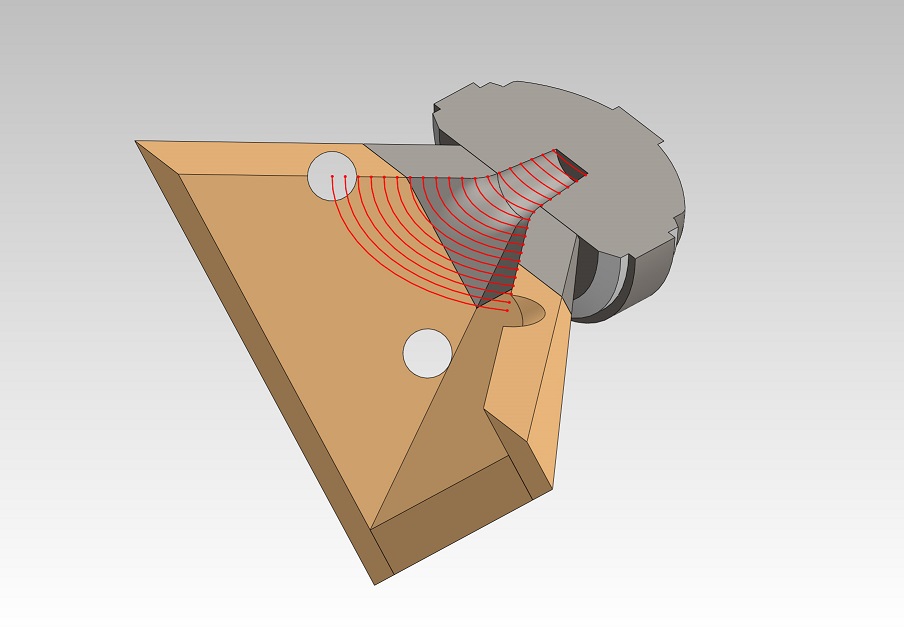
Last edited:
This is probobly a bit off topic, but since there's so many knowledgable people on Unity's I'll ask anyways. Any reason why the Selenium D250 X-1 can't/ shouldn't be used as a Unity mid?
Might work if you can package it. Here's another that goes lower in frequency: Atlas PD-5VH
Last edited:
How did you build the transition from the CD to the horn?
Not sure I could get an exact perfect fit to make the transition seem less by my hands. Maybe have to have a CNC do it for me. But then I could also do the first prototype with a hole cutter or forsner bit to get close then use a rasp or whatever its called to make it as close as I can. Would be a perfect exit on all sides but close enough for me trying to do my first one. Bad idea?
I also thought about using a BA CD from Erick at DIYsound group. Trying to buy only once and having a CD capable of high spl and value for money are the wants in my mind. PLUS BA can handle 1000hz easily.. Just dont want to be on a chase of trying out different CD's with my limited budget.
Not sure I could get an exact perfect fit to make the transition seem less by my hands. Maybe have to have a CNC do it for me. But then I could also do the first prototype with a hole cutter or forsner bit to get close then use a rasp or whatever its called to make it as close as I can. Would be a perfect exit on all sides but close enough for me trying to do my first one. Bad idea?
I also thought about using a BA CD from Erick at DIYsound group. Trying to buy only once and having a CD capable of high spl and value for money are the wants in my mind. PLUS BA can handle 1000hz easily.. Just dont want to be on a chase of trying out different CD's with my limited budget.
How did you build the transition from the CD to the horn?
CAD file here
Samples here
On a budget, go for one of these: D250P
Last edited:
- Home
- Loudspeakers
- Multi-Way
- Suitable midrange cone, for bandpass mid in Unity horn.
